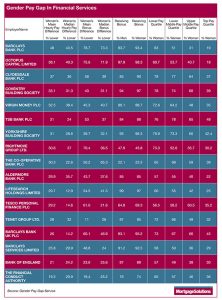
The data was released yesterday as part of Barclays group’s annual results and Treasury Select Committee chair Nicky Morgan has branded the revelation “shocking”.
She also warned that financial services organisations may be called before the committee of MPs to justify their results.
Results from Barclays Bank UK and Barclays Services were slightly better, but still showed that women’s mean hourly pay was on average 26% lower than that of men in the organisations.
In its annual report published today, Royal Bank of Scotland (RBS) revealed a gender pay gap in Great Britain of 37.2% with a gender bonus gap of 64.4% – putting it among those with the biggest gaps.
Pay differences at the Bank of England and Financial Conduct Authority were also significant at around 20% for pay and 25% for bonuses. According to the Office for National Statistics, the median hourly pay gap has fallen from 10.5% in 2011 to 9.1% in 2017.
No seniority
Gender pay gap reporting is compulsory for firms of 250 employees or more and the deadline to submit the first annual report is 4 April.
Of the 1,155 firms that have reported their gender pay gap so far, just 31 (2.7%) have gender pay parity while 153 (13.2%) pay women more.
None of the major financial services firms to have reported so far fall into either of these groups.
Mortgage Solutions has collated the data applying to some of the financial services and property industries’ key firms from the government’s gender pay gap reporting service.
For those with the biggest pay gaps (see table), it appears a lack of women in senior and highest paid positions is the most obvious reason for the difference.
RBS’ data is not yet available on the government’s reporting service, so is not included in the table below.
RBS said it was confident that it paid employees fairly and it kept HR policies and processes under regular review to ensure this was the case.
“A key driver behind the gap is the fact that we have more men in senior roles (which attract higher pay) than women,” it said.
“We have a positive action approach in place, tailored by business, according to the specific challenges they face. As we continue to increase the proportion of women working in senior roles, we expect our gender pay gap will lessen,” it added.
Shocking case
Barclays is a member of the Women in Finance group and has set goals to improve the percentage of female managing directors and directors to 26% by the end of 2018, 33% across the board of directors by 2020 and 33% among the group executive committee and their direct reports.
Morgan was scathing in her criticism of Barclays International, saying: “For this to be the case in 2018 is shocking. Barclays has signed up to the Women in Finance Charter, which commits signatories to supporting the progression of women into senior roles in the financial services sector.
“One way of reducing the gender pay gap is to increase the proportion of women in more senior roles, so it appears that Barclays is on the right track.”
She also warned that firms would be scrutinised by the committee.
“As part of our Women in Finance inquiry, we will keep a close eye on organisations as they report their gender pay gap before the April 2018 deadline,” she said.
“We may call for organisations to give evidence to the committee to hear about best practice. Financial firms should be prepared to explain any gender pay gap that they may have,” she added.
2020 goals
In its annual results report, Barclays said it was confident that men and women across its organisation were paid equally for doing the same job.
“The demographics of our population and the resulting gender pay gaps emphasise the importance of maintaining our firm commitment to increasing female representation across Barclays, particularly among the senior leadership population,” it said.
“We welcome the introduction of gender pay gap reporting to bring further focus to our commitment to improving gender diversity – a commitment that is, and will remain, at the core of our talent management and leadership succession processes.
“We recognise that tackling the gender pay gap will take time and therefore it is key that we remain focused on improving gender diversity through a workplace environment and culture that supports and empowers women,” it added.
Promoting policies
Octopus Capital, which also comes high up the list, includes specialist lender Octopus Property and was one of the first firms to report its data last summer.
Octopus Group CEO and co-founder Simon Rogerson said men and women doing the same roles were paid the same but acknowledged the challenge was not having enough women in senior positions.
“Our gender pay gap report has highlighted this and we’ve set up number of work streams to look into how we can work with our existing talent within the business to help women progress in their careers,” he said.
“As one of the fastest growing businesses in the UK attracting and retaining talent is a key priority for us, and we are absolutely committed to ensuring our staff are paid fairly, irrespective of gender or any other aspect of diversity.”
These policies include:
- encouraging all recruitment partners to shortlist a balanced and diverse set of candidates for every vacancy;
- incorporating a gender analysis tool into the annual pay process, to help managers see the impact of salary and bonus decisions in their teams’ gender pay gap;
- promote existing policies more loudly – such as flexible working and shared parental leave;
- offer a maternity and paternity mentoring scheme to all staff, alongside the more general mentoring programme.

















